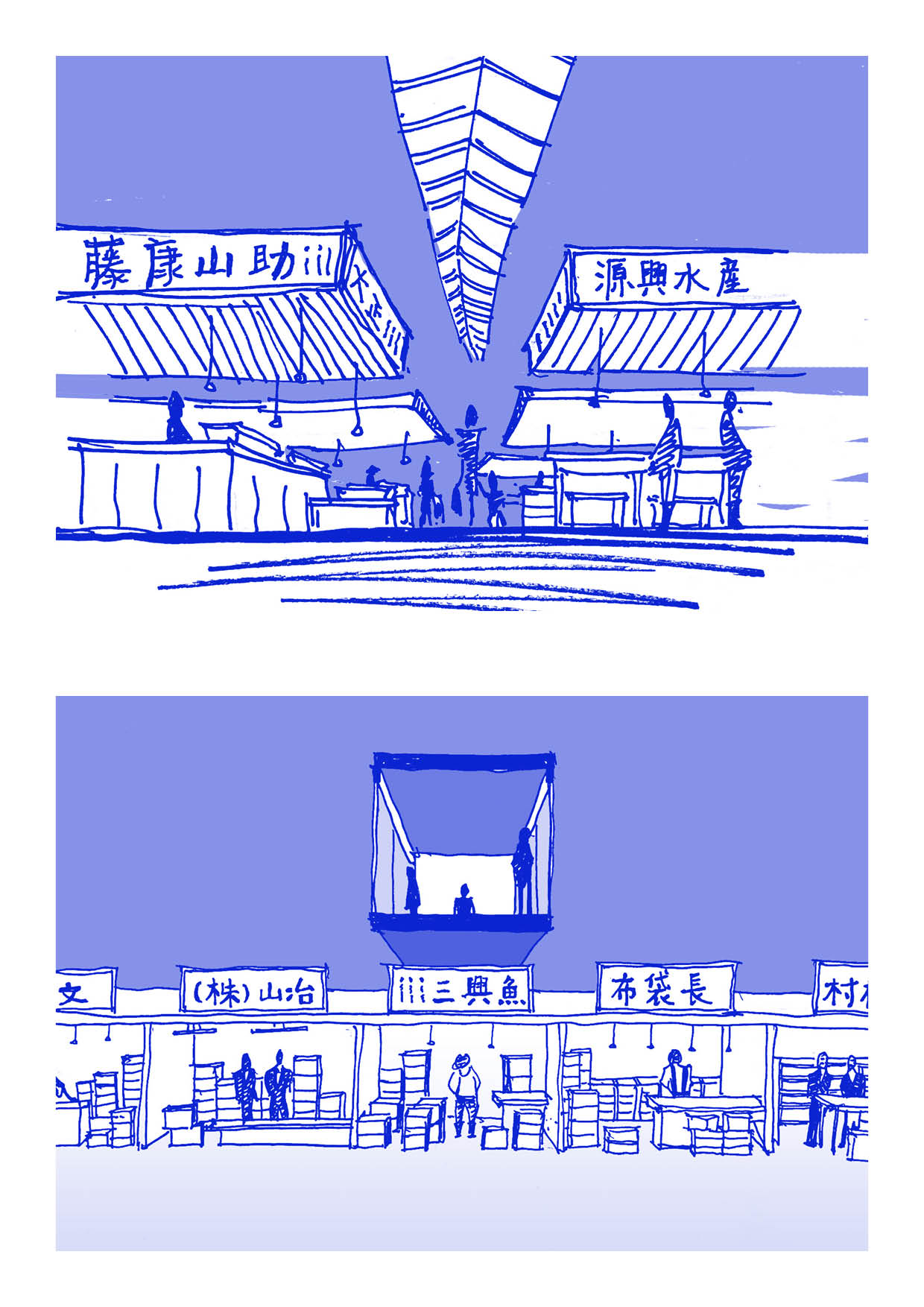
From Tsukiji to Toyosu
Failure of a system, Food, Consumption, Building, Tokyo, Transportation, Culture, Economy, Lifestyle, Illustration
The Tsukiji Market, opened in 1935, is one of the 11 central wholesale markets in Tokyo and the largest fish market in the world. The market conducts fish auctions every day. Through the auction, intermediate wholesalers will buy the fish they want to sell from the general wholesaler. In the market, intermediate wholesalers also sell various aquatic products to different restaurants, retail stores and residents. Tsukiji market is more like a museum of aquatic products, occupying an important position in Japanese food culture.
The Tsukiji market was originally designed based on the railway transportation system. In the subsequent operation process, refrigerated trucks gradually dominated, so the design of the Tsukiji market was outdated. In the 1960s, market relocation was put on the agenda. After 40 years of debate, the government announced in 2001 that it would relocate the Tsukiji market to Toyosu1. In addition, the Tsukiji Market has old buildings, poor sanitary conditions, and is close to the city center. The high land prices are also important reasons for market relocation.
On October 6, 2018, the Tsukiji market was permanently closed, and was later converted into a parking lot for the 2020 Tokyo Olympics. Toyosu Market began to operate. There is a planned visit path in Toyosu Market. You can watch the fish auction and the intermediate wholesale market operation from a bird’s-eye view in the glass corridor. Toyosu Market hopes to establish itself as a museum of Japanese food culture and aquatic knowledge. But unlike the Tsukiji market, in order to prevent tourists from affecting the operation of the fish market, only qualified restaurants and retail stores can enter the fish intermediate wholesale market to buy. There is a lack of close-up viewing and communication. With specific visits and posters, it is difficult to understand how aquatic products affect Japanese food culture. This is also the cultural connotation that the Toyosu Market lacks compared with Tsukiji market.
1. Akiko Katayama, “The World Biggest Fish Market Tsukiji Moved To Toyosu. How Is The New Market Doing?”. Accessed March 8, 2020. https://www.forbes.com/sites/akikokatayama/2019/02/25/the-world-biggest-fish-market-tsukiji-moved-to-toyosu-how-is-the-new-market-doing/#2b04181926c8
See photos: Tokyo
Listen audio: 2, 3
Failure of a system, Food, Consumption, Building, Tokyo, Transportation, Culture, Economy, Lifestyle, Illustration
The Tsukiji Market, opened in 1935, is one of the 11 central wholesale markets in Tokyo and the largest fish market in the world. The market conducts fish auctions every day. Through the auction, intermediate wholesalers will buy the fish they want to sell from the general wholesaler. In the market, intermediate wholesalers also sell various aquatic products to different restaurants, retail stores and residents. Tsukiji market is more like a museum of aquatic products, occupying an important position in Japanese food culture.
The Tsukiji market was originally designed based on the railway transportation system. In the subsequent operation process, refrigerated trucks gradually dominated, so the design of the Tsukiji market was outdated. In the 1960s, market relocation was put on the agenda. After 40 years of debate, the government announced in 2001 that it would relocate the Tsukiji market to Toyosu1. In addition, the Tsukiji Market has old buildings, poor sanitary conditions, and is close to the city center. The high land prices are also important reasons for market relocation.
On October 6, 2018, the Tsukiji market was permanently closed, and was later converted into a parking lot for the 2020 Tokyo Olympics. Toyosu Market began to operate. There is a planned visit path in Toyosu Market. You can watch the fish auction and the intermediate wholesale market operation from a bird’s-eye view in the glass corridor. Toyosu Market hopes to establish itself as a museum of Japanese food culture and aquatic knowledge. But unlike the Tsukiji market, in order to prevent tourists from affecting the operation of the fish market, only qualified restaurants and retail stores can enter the fish intermediate wholesale market to buy. There is a lack of close-up viewing and communication. With specific visits and posters, it is difficult to understand how aquatic products affect Japanese food culture. This is also the cultural connotation that the Toyosu Market lacks compared with Tsukiji market.
1. Akiko Katayama, “The World Biggest Fish Market Tsukiji Moved To Toyosu. How Is The New Market Doing?”. Accessed March 8, 2020. https://www.forbes.com/sites/akikokatayama/2019/02/25/the-world-biggest-fish-market-tsukiji-moved-to-toyosu-how-is-the-new-market-doing/#2b04181926c8
See photos: Tokyo
Listen audio: 2, 3


